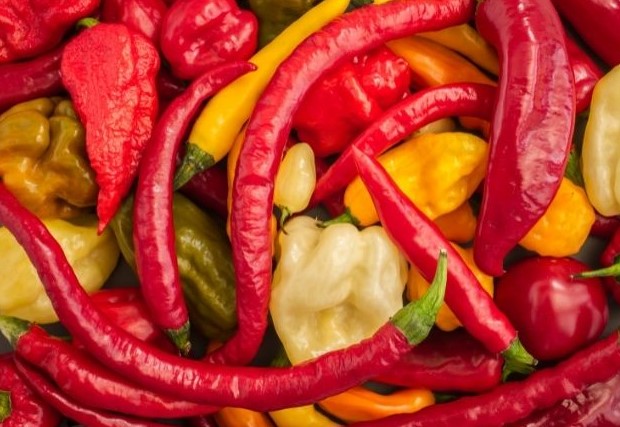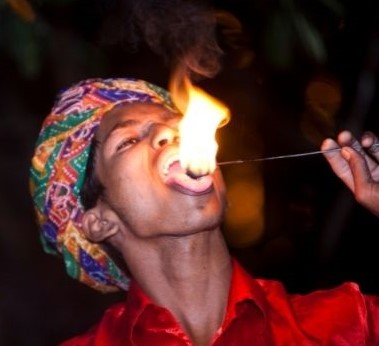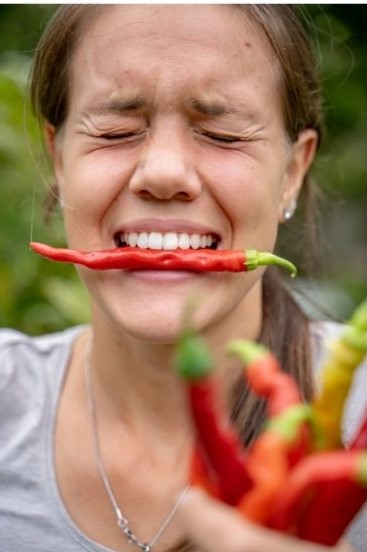Michelle’s Review: An entertaining read on the spectrum of spicy foods “peppered” with her usual saucy sense of humor.


Hot!He heedlessly ripped the bodice of her dress as he pressed his body to her hot bosom in a crushing embrace. She of the burning lips wondered if she left the stove on after whipping up a Thai curry to satisfy her own desires. Hey! Isn’t that much better than just coming right out and telling you this is another blog about food? I promise to make it spicy!
I clearly remember my first encounter with hot food. Spicy hot food. I had recently moved to Texas from my white bread neighborhood in suburban New Jersey. The spiciest thing I had ever tasted was some Italian sausage my mom added to her spaghetti sauce. I didn’t like it. My new co-worker supplied a lasagna for a work pot-luck lunch. I brought white bread. As soon as that lasagna hit my mouth, I ceased to exist. Instead of happy me sitting there enjoying a celebratory lunch with my co-workers, there was me transformed into a writhing ball of pain. It did not occur to them that I should be warned, that I might never have experienced a Cajun-made lasagna. My naïve young self never heard the word Cajun before. Lasagna, I knew!

Simple ingredientsI had lived in New Jersey! Lasagna is an Italian dish that generally does not burn one’s lips off. Lasagna has noodles and cheese, some ground beef and tomato sauce and NOTHING ELSE! Hoo! My co-workers quickly handed me the basket of bread I had so painstakingly sliced and wrapped in a cloth napkin for snappy display, while slapping my hand away from the glass of water I blindly sought. All of my senses condensed into that horrendous mouthy point of reference, which required quenching. My dad was a fireman and I had been trained since early childhood how to put out flames…just not those which had ignited in my head space. Water, I was told, simply distributed the offending substance in the hot sauce to other areas of the mouth. Bland, spongy bread is the most efficient extinguisher.
So, this was my trial by fire, so to speak, and an introduction into the hot pepper cultures of the south, foods fiery enough to make a white Yankee girl want to run back to mom’s soothing tuna noodle casserole. After stuffing bread into my mouth and using a piece to dry my tears, I became coherent enough to ask why. Why was it so hot? That Cajun word returned in an attempt to explain hot sauce and its many applications. I was ignorant of the variety of hot peppers that grow on this earth and also of the reason for actually eating them. I became wary of any food cooked by friends from Louisiana. Asking if the food being offered to me is spicy is an insufficient inquiry, as one person’s killer-hot is another one’s not-really (complete with a dismissive wave of the hand). Lesson learned: Trust no one.

Consume with cautionI’ve had 45 years since then to explore the world of cooking with peppers. Hot peppers are popular all over the world and are numerous in their variety and heat. What makes a pepper hot is a chemical called capsaicin and the heat index (Scoville units) in which peppers are sorted is determined by their level of this component, which can range from barely a singe to you might as well go on and die. Perversely, growers are still trying to cultivate a pepper which Guinness could designate as the hottest pepper on earth. As an example of relative heat, The Carolina Reaper has a rating of over 2 million Scoville units, and might be considered one of the hottest peppers consumed by humans, while the lowly jalapeño is a mere 10,000. As a newly minted Texan, I started exploring Mexican cuisine. In the enchiladas and salsas, I discovered the jalapeño, and the wider world of mouth-burning, eye-watering food was freshly opened to me. My plan was to learn how to avoid ever tasting anything that might spark an embarrassing public display of intolerance for the sainted jalapeño. As one might expect, as time went on, my palate matured to one of a playful willingness to try a nibble, a wary, experimental tad of a pepper-infused dish. All these years later, I’m a little wiser as to what I can deal with in terms of spicy heat and what any given pepper adds to the flavor profile of a dish which warrants including its burning sensation.

Looks innocent enoughHaving the restaurants of Houston (the most diverse city in the country) at my disposal, I expanded my culinary explorations by dining at restaurants serving cuisine from all over the globe. My next stop was Chinese food. I had, by the age of 19, only eaten in a Chinese restaurant once. My exposure to this cuisine was limited to Chun King canned chow mein, so it was with shock that I was introduced to the Tien Tsin Chinese red pepper. Compared to the jalapeño, it was a shocking introduction into the upper thresholds of pain. Surely, I thought after biting into one, there had been some mistake in serving me something normally used for torturing prisoners of war. After 75,000 Scoville units of capsaicin hit my mouth, I thought I might have to be taken to the emergency room. Sweating and crying and waving hands in front of my mouth (the international signal for My mouth is on fire), I remembered the bread remedy rendered by my work colleagues. Rice is bread’s fire extinguisher equivalent. Always order plain white rice and root around in your food in order to fish out those little red peppers.
I am now much more attuned to those little chili symbols on menus which designate how much heat one may expect in a dish. They are not in any way reliable since heat is always relative. I moved on to Thai food. Thai chilies have a range of heat, but you can always count on your Thai food to kill any wayward microbes in your gut and maybe even some of the microbes you wanted to keep alive. Peppers used in this food culture can be upward of 100,000 Scoville units. By this point in my food explorations, Mexican food started to seem like a jar of Gerber’s baby food.
I confess I love Thai food. The curries, the noodles, the inherent danger. In restaurants, I learned to ask for low heat and have sometimes been surprised by what they think constitutes low heat. I’ve managed to develop some tolerance for medium heat if there’s plenty of rice or noodles to diminish the flames. This change in heat-tolerant conditions lead me to the inevitable dalliance with Indian food.

OuchIndian food is really hot. Pork Vindaloo—host of the infamous Ghost Pepper (a walloping 1.1 million Scoville units) might just be considered a lethal weapon, not to be outdone by the west Indian Volcanic Curry made with the Naga Morich pepper (aka serpent chili), said to have a venomous bite which may possibly blow one’s head off. By the time I was brave enough to try Indian food, I was worldly enough to have done my homework. My strategy was to ask waitstaff for suggestions which might please a person with an aversion to having one’s head blown off or even the slightest hint of hair smoke. Spicy enough to awaken the heat sensors in the mouth but with no need for any antidote stronger than a raita (yogurt sauce) and some plain naan (bread!) I have grown to love vegetarian Indian dishes approaching their consumption as I would any simmering paperback romance, with prudence and the proper precautions.

Experimenting with fresh chilies in my own cooking has been something of an adventure as well. I caution guests whenever I use peppers in my meal, probing for aversions to any level of heat. My own tastes and comfort stop at the serrano pepper, slightly higher in heat than a jalapeño. Every pepper that rates under that in Scoville units is welcome in my kitchen. Hatch, Guajillo, Ancho, Poblano, Shishito and of course, the wonderful Jalapeño. Anything hotter will give me flashbacks to that Cajun lasagna and my little Tabasco flashfire. She of the burning lips is in charge of her own desires– peppers, torn bodice and all.
Here’s to adventurous meals,
Cheryl
Guest Editor Michelle says she likes spicy food and could really dig into this story. The editing was easier than eating a habanero!




ah! spicy! before moving to Texas, mustard was the spiciest thing I’d ever had. Now I love Mexican hot sauce to dip my chips in. Every so often I manage a hottish dish, but always give jalapeño slices to Jim!
I would like to try pickling the jalapenos we are growing in the garden!
My Mom used to make curry chicken, but it wasn’t spicy. My brother ordered it at a restaurant and he was very surprised 😯
Authentic ethnic restaurants always surprise us!! I never heard of curry until I moved to Houston.
I have learned to love the yellow curry at Thai Spice, but that’s a about it for me on the spice continuum. When in London, I naively tried a yellow curry in a restaurant there … if you ever get the chance to try it, just don’t!
The worst is when you think you know how it will be and then are so unpleasantly surprised!
Tolerance of capsaicin is genetic. Some people, over time, can increase their tolerance while some never will. My tolerance has become insanely high over the decades. Even Ms Bear has now taken to putting Crystal hot sauce in our scrambled eggs! I do have an upper level that I don’t like to cross. I once had some ghost pepper ruin my entire day LOL. Heavy cream is great for extinguishing the fire as it is a base that counteracts the acid in capsaicin.
The Bear family does like their hot stuff!
Andy grows both ghost and Carolina reapers. I stay far away.
But does he eat them? It doesn’t seem humanly possible!